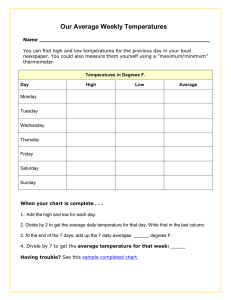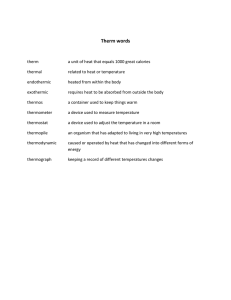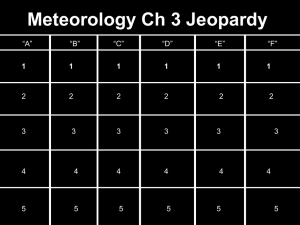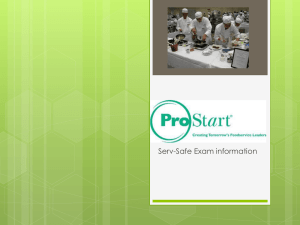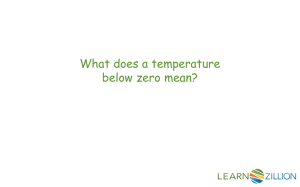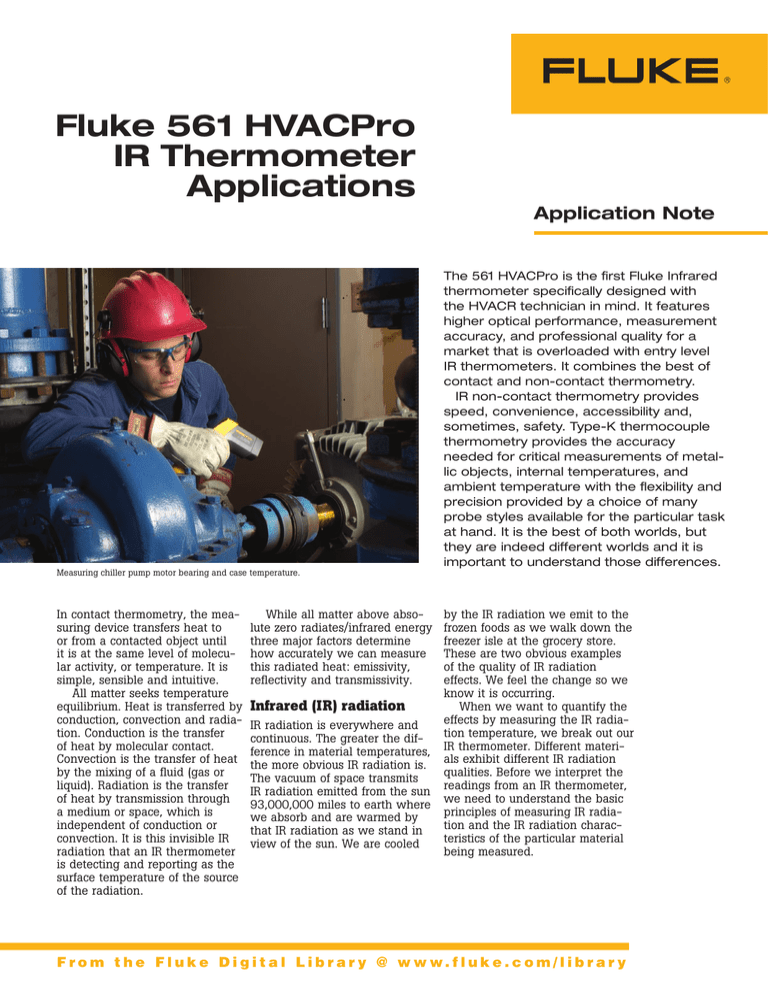
Fluke 561 HVACPro
IR Thermometer
Applications
Measuring chiller pump motor bearing and case temperature.
In contact thermometry, the measuring device transfers heat to
or from a contacted object until
it is at the same level of molecular activity, or temperature. It is
simple, sensible and intuitive.
All matter seeks temperature
equilibrium. Heat is transferred by
conduction, convection and radiation. Conduction is the transfer
of heat by molecular contact.
Convection is the transfer of heat
by the mixing of a fluid (gas or
liquid). Radiation is the transfer
of heat by transmission through
a medium or space, which is
independent of conduction or
convection. It is this invisible IR
radiation that an IR thermometer
is detecting and reporting as the
surface temperature of the source
of the radiation.
While all matter above absolute zero radiates/infrared energy
three major factors determine
how accurately we can measure
this radiated heat: emissivity,
reflectivity and transmissivity.
Infrared (IR) radiation
IR radiation is everywhere and
continuous. The greater the difference in material temperatures,
the more obvious IR radiation is.
The vacuum of space transmits
IR radiation emitted from the sun
93,000,000 miles to earth where
we absorb and are warmed by
that IR radiation as we stand in
view of the sun. We are cooled
Application Note
The 561 HVACPro is the first Fluke Infrared
thermometer specifically designed with
the HVACR technician in mind. It features
higher optical performance, measurement
accuracy, and professional quality for a
market that is overloaded with entry level
IR thermometers. It combines the best of
contact and non-contact thermometry.
IR non-contact thermometry provides
speed, convenience, accessibility and,
sometimes, safety. Type-K thermocouple
thermometry provides the accuracy
needed for critical measurements of metallic objects, internal temperatures, and
ambient temperature with the flexibility and
precision provided by a choice of many
probe styles available for the particular task
at hand. It is the best of both worlds, but
they are indeed different worlds and it is
important to understand those differences.
by the IR radiation we emit to the
frozen foods as we walk down the
freezer isle at the grocery store.
These are two obvious examples
of the quality of IR radiation
effects. We feel the change so we
know it is occurring.
When we want to quantify the
effects by measuring the IR radiation temperature, we break out our
IR thermometer. Different materials exhibit different IR radiation
qualities. Before we interpret the
readings from an IR thermometer,
we need to understand the basic
principles of measuring IR radiation and the IR radiation characteristics of the particular material
being measured.
F ro m t h e F l u k e D i g i t a l L i b r a r y @ w w w. f l u k e . c o m / l i b r a r y
Emissivity is the quality of a
material that allows it to radiate
its heat from its surface.
Reflectivity is the quality of a
material that allows it to reflect
radiated heat from another
source.
Reflected
561 HVACPro
IR THERMOMETER
Transmitted
Emitted
Transmissivity is the quality
of a material that allows radiation from another source to
pass through it.
Absorption is the quality of
a material to receive radiation
from another source.
IR radiation = absorption +
reflection + transmission
Copper blackened by very heavy
oxidation has even less reflectivWhatever IR radiation is emitted, ity with proportionately more
will be absorbed. So absorption
emissivity (0.88). Most painted
= emissivity. It is the IR radiation surfaces have very high emisemitted from a surface that the IR sivity (0.9-0.95) and negligible
thermometer reads. An IR therreflectivity.
mometer cannot read IR radiation
The only setting on most IR
transmitted in the air (gas), so
thermometers is for the emissivwe can ignore transmissivity by
ity rating of a material, and in
most field work. This leaves us
many cases, that will be preset
with a basic IR radiation meaat 0.95, which works quite well
surement formula.
for organic and painted surfaces.
An emissivity adjustment feaIR radiation = emissivity
ture allows the thermometer to
- reflectivity
compensate for less IR radiation
Reflectivity is inversely proportional to emissivity. The more an emitted by some material surfaces, particularly metals. Reflecobject reflects IR radiation, the
tivity is only an issue if there is a
less it emits. Reflectivity often
source of high temperature emiscan be relatively judged accordsion
in the vicinity of a surface
ing to our visual determinations
being measured that can reflect
of reflectivity. New copper has
that nearby high temperature IR
a very high reflectivity and low
emissivity (0.07-0.2). Copper that radiation.
is oxidized has less reflectivity
and more emissivity (0.6-0.7).
2 Fluke Corporation
Fluke 561 HVACPro IR Thermometer applications
The 561 HVACPro has three
emissivity settings: High (0.95),
medium (0.7), and low (0.4).
There are three methods of
determining the emissivity. One,
use a chart that lists the emissivity of various materials, or two,
apply a piece of black electrical
tape to the surface being measured. Apply the tape to the surface, compare the measured IR
temperature of the taped to the
bare surface, adjust emissivity
until the temperatures match or
closely match. The third method
is to plug a K-type contact probe
into the 561 HVACPro to measure
surface temperature while reading IR temperature, then adjust
emissivity until the IR temperature display most closely matches
the KTC temperature display.
Examples:
•
•
•
•
•
•
•
•
•
Polished Brass: 0.03
Oxidized Brass: 0.61
Roughly Polished Copper: 0.07
Black Oxidized Copper: 0.78
Black Lacquer Paint: 0.96
Commercial Sheet Aluminum: 0.09
Oxidized Lead: 0.43
Rusted Iron: 0.78
Organic/painted materials 0.95
IR or contact thermometry: the choices
Use the IR temperature function when speed, convenience,
accessibility, safety, trending,
surface temperature or temperature comparisons are the key
consideration.
Use the contact thermocouple
function when internal temperature, ambient temperature or the
accuracy of critical temperatures
of metallic objects are prime.
Use both together when a temperature differential between a
surface (IR) and the air (KTC) is
key, or when adjusting the IR
emissivity setting.
The IR advantage
Speed, convenience and accessibility top the list for IR vs.
contact thermometry. The 561
HVACPro takes less than 500
milliseconds to display an IR
temperature. With contact thermometry, the probe must be
in good thermal contact with
a cleaned surface, and time
allowed for the probe to sink
heat and reach equilibrium with
the surface. This can take minutes, and the surface must be
accessible and safe to measure.
Many IR temperature readings
can be made in less time than it
takes to prepare a surface, attach
a probe, and wait for temperature equilibrium.
Many of the temperatures
sought in the HVAC/R trades
are more qualitative than quantitative (“qualitative” meaning
relative/comparative temperatures and “quantitative” meaning
specific, accurate temperatures).
And, on most surfaces, the IR
temperature is highly accurate
and will be your primary choice
except on critical temperatures
such as superheat and subcooling, or for air temperatures
which a IR thermometer cannot
read directly.
While scanning without the
thermocouple connected, the 561
HVACPro can record maximum,
minimum, and differential temperatures. One at a time, these
temperatures can be read in the
secondary display. During or
after the scan, the rocker button
can be used to scroll between
these values. Releasing and pulling the trigger will begin recording new values to store.
•
•
•
Measuring temperature of fuses and electrical connections.
3 Fluke Corporation
Fluke 561 HVACPro IR Thermometer applications
IR thermometers are invaluable for walk-through assessments of building surfaces
from indoors or outdoors.
Providing accessibility through
heights and distances, an IR
thermometer can scan building
envelope surfaces for temperatures that could indicate points
of infiltration or insulation
deficiencies. Scan along baseboards and around windows
and doors for building envelope integrity.
Discharge temperatures of
grills, diffusers and registers
can be quickly determined
from a comfortable stance in
a convenient location. The IR
thermometer does not directly
measure the temperature of
the air but of a nearby surface
that has equilibrated to the
air stream. Effects of register
throw and evidence of stagnant zones can be determined
by scanning ceiling and wall
surfaces.
Scanning ductwork for air leaks
or quality of insulation is quick
work. Duct insulation surface
temperature should never be
less than 5 °F (-15 °C) above
the highest ambient dew point
temperature to prevent sweating. Relative humidity at the
duct insulation surface should
remain below 60 % RH to
prevent mold growth. These
same rules apply for scanning basement or crawlspace
surfaces. The Fluke 971 Humidity meter is a perfect companion for the 561 HVACPro when
checking for conditions that
can support mold growth. The
971 displays air temperature,
wet bulb temperature, dew
point temperature, and relative
humidity.
CPro
561 HVA ETER
OM
IR THERM
To troubleshoot compressor discharge line temperature use an IR thermometer
to survey temperatures at the compressor head, compressor oil sump,
evaporator coil and suction line, discharge line, condensor coil and liquid line,
and fan motor.
•
•
•
•
•
IR thermometers are perfect
for routine trending of equipment operating temperatures.
Scan compressor discharge
and suction line temperatures,
compressor head and sump
temperatures, capacity control
operation.
Compare motor or blower bearings for equivalent operating
temperatures. Scan sheaves
from the hub to the circumference for even temperature.
Elevated sheave temperature
at the circumference points to
slipping belts. (Don’t try this
with a contact thermometer
probe.)
Scan evaporator or condenser
hairpins and U-bends, distributor tubes, or driers for restrictions.
Scan reversing valve pilot
tubes for proper discharge or
suction gas flow.
Scan steam pipes and traps for
proper operation, or indicators
that will lead to the source of
problems.
4 Fluke Corporation
•
•
•
•
•
Scan for temperature differential between hydronic supply
and return loops and temperature rise across boiler supply
and return lines.
Scan to locate radiant heat
loops.
Scan energy recovery wheels
for effectiveness.
Scan for discharge temperatures of unit heaters mounted
high above a warehouse floor.
Scan a room thermostat case
to compare to temperature
displayed by the thermostat.
IR thermometers allow you to
safely check temperatures in
locations such as live electrical
circuits that would be difficult
or dangerous to access with a
contact thermometer. Loose or
poor quality electrical connections are sure to fail, sometimes
catastrophically. Poor electrical
connections have increased resistance, which results in increased
temperature. Elevated temperatures will direct the mechanic to
Fluke 561 HVACPro IR Thermometer applications
a closer mechanical inspection of
the device. Relays and contactors have full load operating
temperature rise specifications
that can assist in the determination whether or
not they are operating within
parameters.
• Scan contactors or starters for
elevated temperatures between
fixed and movable contacts,
and at the lug connections.
Look for temperature differentials between poles. Each
pole should have equivalent
temperatures under equivalent
load. If one pole has elevated
temperatures compared to the
other poles, that indicates a
problem.
• Scan relay connections and
relay case for elevated temperatures.
• Scan disconnects, buss connections and fuses for elevated
temperatures. Look for equivalent temperatures between
poles. Remember that the
emissivity for the paper covering of a fuse is higher than
the emissivity of a clean bare
conductor.
• Scan wire nut or bug connections for elevated temperature.
• Scan along the length of
conductor insulation for consistent temperature.
Remember to always follow
electrical safety procedures. The
higher the voltage, the quicker
it can find an alternate path to
ground. Don’t let that path be you.
Taking a contact temperature measurement at the compressor outlet on the liquid line.
Contact thermometry
There are times when there is no
substitute for contact thermometry. Critical temperatures such as
superheat and subcooling require
good contact thermometry to
obtain the required accuracy and
precision. Suction line superheat
of systems using a fixed restrictor metering device is a critical
temperature.
Forty years ago, expected
liquid line subcooling may have
been 20 °F (-6 °C) or even more
for some equipment. Today,
especially with the new 13 SEER
minimum efficiency requirement
of all single phase comfort cooling air conditioners and heat
pumps 5 tons or less, liquid line
subcooling of thermal expansion valve equipment is a critical temperature. 10 °F (-12 °C)
of subcooling for modern TXV
equipped systems is no longer
necessarily a valid target. High
efficient equipment frequently
requires subcooling values less
than 10 °F. Subcooling values
are sometimes listed with tenths
of a degree target value. Some
smaller capacity equipment is
even listed with subcooling values as low as 3 °F (-16 °C). So
now, even subcooling is a critical
value.
An IR thermometer cannot measure air temperature
directly, so contact thermometry
is required for this purpose. Air
temperature rise across a furnace still requires a probe to
be inserted into the ductwork.
Accurate conditioned space or
outdoor air temperatures need
to be taken by the thermocouple
probe. Low mass boilers should
have the temperature rise taken
by contact thermocouples for
accuracy.
When IR temperatures are not
what is expected, use a thermocouple probe to verify accuracy.
HVAC/R technicians rarely rely
on a single test, or reading, to
condemn a process. They use all
of the techniques in their bag of
tricks to validate their diagnosis.
With two temperature technologies in one tool, with simultaneous display, the technological
bag of tricks just expanded.
The 561 HVACPro comes
equipped with a type-K thermocouple, complete with a
Velcro strap for fastening to pipe
surfaces. Any of the other type-K
thermocouples with a standard
mini-connector you may already
have can also be used. While
bead thermocouples are versatile
and very portable, they are not
necessarily the best choice for all
purposes.
The Fluke 80PK-8 pipe clamp
thermocouple is a perfect and
fast solution for any temperature
measurement from tubing and
pipes; Subcooling, superheat,
hydronics, service water supply.
The 80PK-26 general purpose
probe with its 8 inch insertion
length and low mass casing
tip is well suited for speedy air
temperatures and surface contact measurements. For both air,
surface and liquid immersion, the
8 inch probe length with pointed
tip of the 80PK-25 is likely to
become one of your essentials.
OFF
kPa psi
ZERO
METRIC
ENGLISH
PRESSURE / VACUUM MODULE
PV350
cmHg in Hg
Compressor
Use a multimeter and a pressure module to quickly and
accurately determine suction pressure.
5 Fluke Corporation
Fluke 561 HVACPro IR Thermometer applications
There is one contradictory
requirement of the two temperature measurement requirements
of the 561 HVACPro. Oxidized
copper will result in more accurate IR temperature readings, but
contact thermometry requires
that the copper be clean since
oxidation acts as an insulator and
will retard the transfer of heat by
conduction.
• Superheat is a critical measurement that must be taken on
equipment utilizing a fixed
restrictor metering device.
Without specific instructions
from the equipment manufacturer, measure superheat
6 inches from the compressor
suction stub. Superheat equals
suction line temperature minus
evaporator temperature. While
a TXV continuously adjusts
refrigerant flow to maintain
a predetermined amount of
superheat at the evaporator outlet, a fixed restrictor
system’s superheat is dependent on several variables that
can be broken down into two:
heat applied to the evaporator
and condensing temperature.
Most superheat tables specify
400 cfm of air per ton of capacity as a baseline for continuing. Given the proper airflow
across a clean evaporator and
condenser, the superheat is
determined by the wet bulb
temperature of the return
air and the outdoor ambient
temperature at the condensing unit (air temperature in
the shade to avoid the effects
of radiant heat from the sun).
6 Fluke Corporation
A quick infrared survey can check for leaks and uneven temperatures in both the heater and pipes.
Since this superheat is a
critical temperature, no “rules
of thumb” should be used in
its place. If the equipment
manufacturer’s superheat chart
or slide rule is not available,
use one supplied by another
manufacturer. Remember that a
good technician will not bless
or condemn a process based on
a single test.
Checking superheat is the last
step. First check cleanliness of
coils, filters, blowers, air flow,
electrical, etc. and know that the
system is ready for the final fine
tuning that superheat assures.
Superheat is the amount of sensible heat added to the refrigerant after all of the refrigerant
Fluke 561 HVACPro IR Thermometer applications
in the evaporator is “boiled” to
a vapor. Adding refrigerant will
reduce the amount of superheat. Recovering refrigerant will
increase the amount of superheat. Low suction pressures do
not necessarily mean low charge.
Check for evaporator and filter
cleanliness, proper air flow, and
suction line temperature before
adding refrigerant.
• Subcooling should be measured
with a contact thermometer
probe. The new NAECA 13
SEER minimum requirement
that became effective in
January 2006 for single phase
equipment 5 tons or less may
introduce you to subcooling
values lower than you are
subcooling. Too little refrigerant results in an undercharge
and insufficient subcooling.
Subcooling equals condensing
temperature minus liquid line
temperature. Some manufacturers may substitute “approach”
temperature values for subcooling temperature values. While
subcooling compares liquid
line temperature to condensing temperature, the approach
temperature compares liquid
line temperature to outdoor
ambient air temperature. The
manufacturer has calculated
what the approach temperature should be to achieve
the desired subcooling. This
allows a technician to check
the charge without attaching gauges. If the approach
temperature is OK and all
of the other checks confirm
proper operation, then there is
no need to attach gauges.
Conclusion
A quick scan can pick up substantial differences in temperature values
that could indicate an insulation leak. Don’t rely on the exact temperature
readings, however, without first adjusting for the emissivity and
reflectivity of the insulation material.
accustomed to seeing. Expect
to see more match-ups that
require thermal expansion
valve metering, high efficiency
condenser and evaporator
motors, and even larger heat
transfer coils.
Since thermal expansion valves
control superheat, liquid line
subcooling is the method
for fine-tuning the refrigerant charge. Proper air flows,
cleanliness of coils and filters,
mechanical integrity and
electrical should be confirmed
correct before adjusting charge
to subcooling values.
7 Fluke Corporation
Subcooling measures how
much the refrigerant has been
cooled below its condensing temperature. In order to
cool the refrigerant below its
condensing temperature, the
refrigerant must be exposed to
the condensing medium long
enough for its temperature
to be reduced sufficiently. In
an air-cooled condenser, the
refrigerant backs up into the
condenser for the air to cool
it below its condensing
temperature. Too much
refrigerant backed up into the
condenser results in an overcharge indicated by too much
Fluke 561 HVACPro IR Thermometer applications
Higher optical performance, measurement accuracy, and professional quality are reason enough
to choose the 561 HVACPro.
Add to this single hand operation, laser sighting, MIN/MAX/DIF
temperature, high-medium-low
emissivity adjustment, bead
thermocouple with Velcro fastener included and you have a
highly accurate and versatile
tool. Equipped with the standard
miniconnector jack for type-K
thermocouples, there are many
general purpose and specialty
probes that can be used in place
of the provided Velcro pipe probe
thermocouple. Additionally, the
companion user guide that comes
with the thermometer has extensive step-by-step procedures for
most of the applications outlined
in this article.
IR thermometer specifications
IR thermometer models are designed
with variable characteristics depending
on the application design. Variables
in model design include distance to
spot ratio, field of view, focus and focal
distance, wavelength of emitted IR
radiation, and environmental operating
conditions.
D:S = 12:1 at focal point
S
Pro
561 HVAC TER
MOME
IR THER
132 mm @ 1500 mm
(5.3 in @ 60 in)
38 mm @ 300mm
(1.5 in @ 12 in)
5 mm @ 900 mm
(3 in @ 36 in)
D
When measuring smaller objects, use
the Fluke 561 within 6 ft (1.75 m) of
the intended target. The measured area
increases with distance (the distance
divided by 12, approximately).
Distance to Spot Ratio
(D:S) is a handy way to approximate the size of the measurement spot on the target relative
to the distance the thermometer
is from the target. A D:S of 12:1
would result in a three inch spot
at a target distance of 36 inches
or a slightly larger than one foot
spot at a target distance of 12
feet. At a given distance, the
larger the D:S ratio, the smaller
the spot. An IR thermometer with
a 90:1 ratio would have about
a 1-1/16 inch measuring spot
at an eight ft distance to target,
is required for sudden changes
of 10 °F or more degrees for
the thermometer to be accurate
under the new conditions.
Particulates in the air (e.g.,
steam, dust, smoke) between the
thermometer and the target will
distort the readings.
Field of View refers to the
Some of the other basic
spot size in relationship to the
specifications
report ranges,
surface being measured. The
accuracy
and
response
time.
spot size should be contained
The
Fluke
561
IR
thermometer
within the perimeter of the target
temperature measuring range is
surface, centered on the area
from -40 °F to 1022 °F at an IR
of interest. Ideally, the surface
wavelength of 8 to 14 microns
being measured should be at
with a response time of less than
least twice the diameter of the
500 milli-seconds. The K-type
spot size for greatest accuracy.
thermocouple included with the
Focus is preset in most IR therFluke 561 has a range is from
mometers at infinity.
-32 °F to 212 °F. Also within are
Minimum Focal Distance is the other specifications and features
that make this an especially
distance from target that results
attractive thermometer such as
in the smallest spot size. With
the ability to record in real time
the 561 HVACPro, the minimum
maximum, minimum and relafocal distance is 36 inches. As
tive IR temperatures. Or a single
thermometer distance to the
handed operation for point and
target is either increased or
shoot measurements with the
decreased, the measuring spot
index finger, guided by a laser
size will increase.
beam site, while simultaneously
Environmental Conditions
scrolling through temperature
are factors that affect the opera- variables with the thumb on a
tion of the IR thermometer. The
rocker button.
ambient operating range (temperature of the 561) should be
between 32 °F to 120 °F within
a relative humidity between 0 %
to 90 % RH as long as moisture
from the air does not condense
onto or into the thermometer.
Accuracy is compromised outside
of these conditions. A thermometer stored overnight in a 30 °F
van and then brought into a
Fluke. Keeping your world
70 °F, 25 % RH (32 °F DPT)
up and running.
environment will cause moisture
from the air to condense on the
Fluke Corporation
cold surfaces of the thermomPO Box 9090, Everett, WA USA 98206
eter. The thermometer storage
Fluke Europe B.V.
PO Box 1186, 5602 BD
temperature range is from -4 °F
Eindhoven, The Netherlands
to 150 °F. An adjustment period
while a thermometer with a 12:1
ratio would have about an 8 inch
measuring spot at an 8 ft distance to target. The laser spot is
for targeting purposes only and
is unrelated to the IR measuring
spot size.
For more information call:
In the U.S.A. (800) 443-5853 or
Fax (425) 446-5116
In Europe/M-East/Africa (31 40) 2 675 200 or
Fax (31 40) 2 675 222
In Canada (800) 36-FLUKE or
Fax (905) 890-6866
From other countries +1 (425) 446-5500 or
Fax +1 (425) 446-5116
Web access: http://www.fluke.com
©2006 Fluke Corporation. All rights reserved.
Printed in U.S.A. 3/2006 2634903 A-EN-N Rev A
8 Fluke Corporation
Fluke 561 HVACPro IR Thermometer applications

